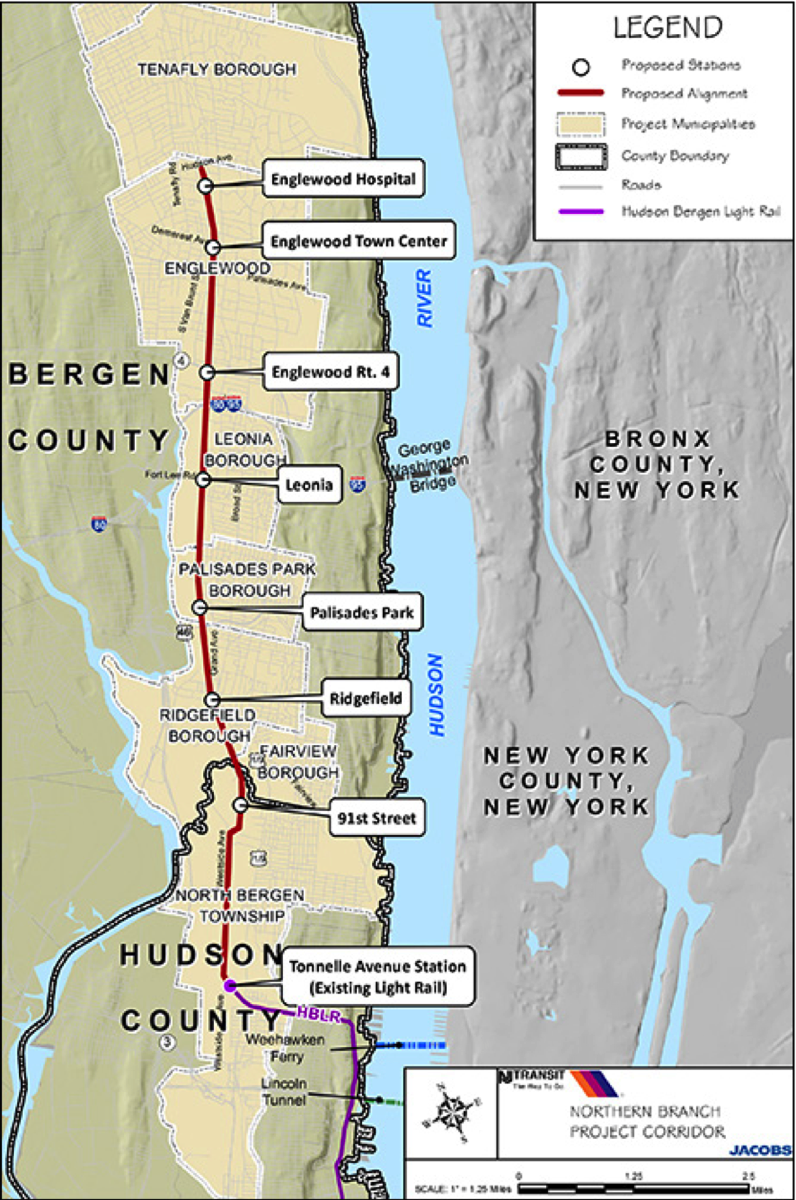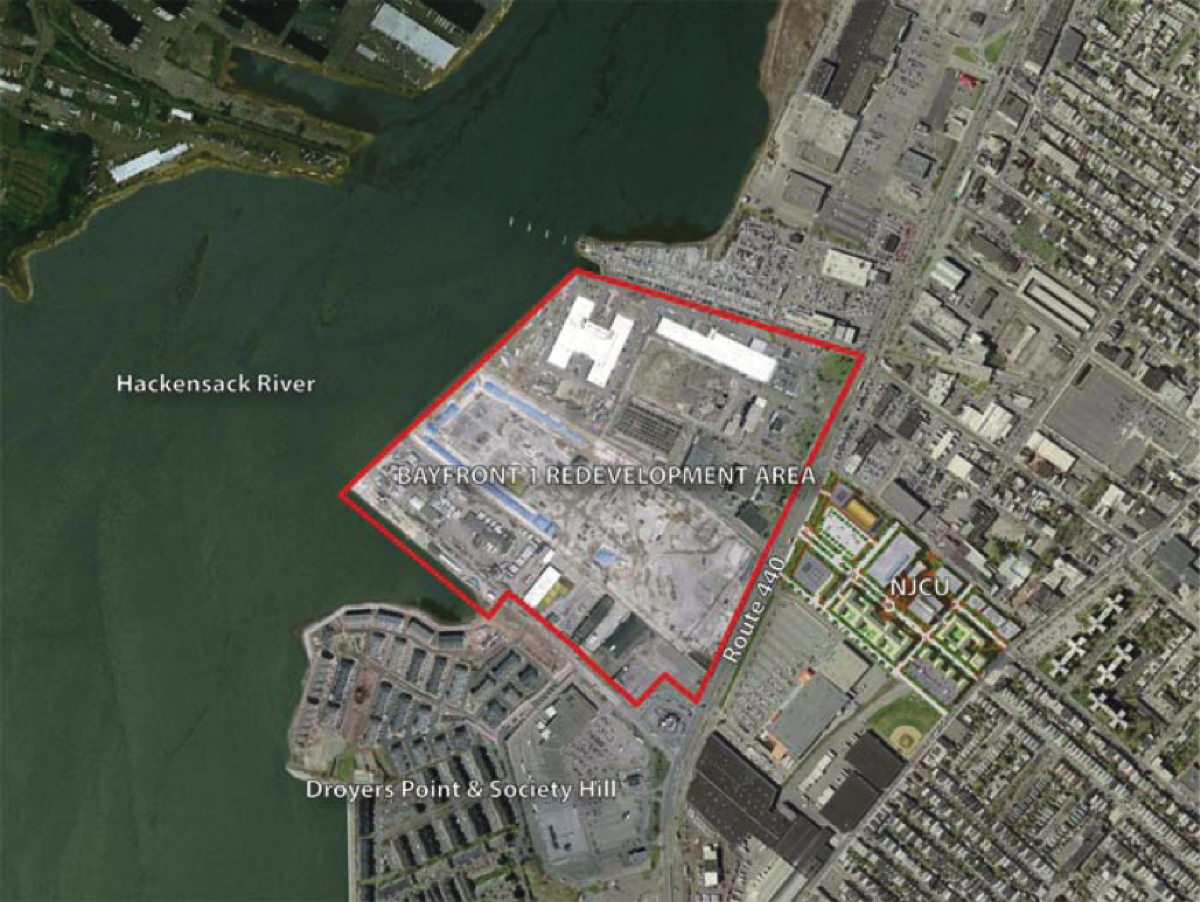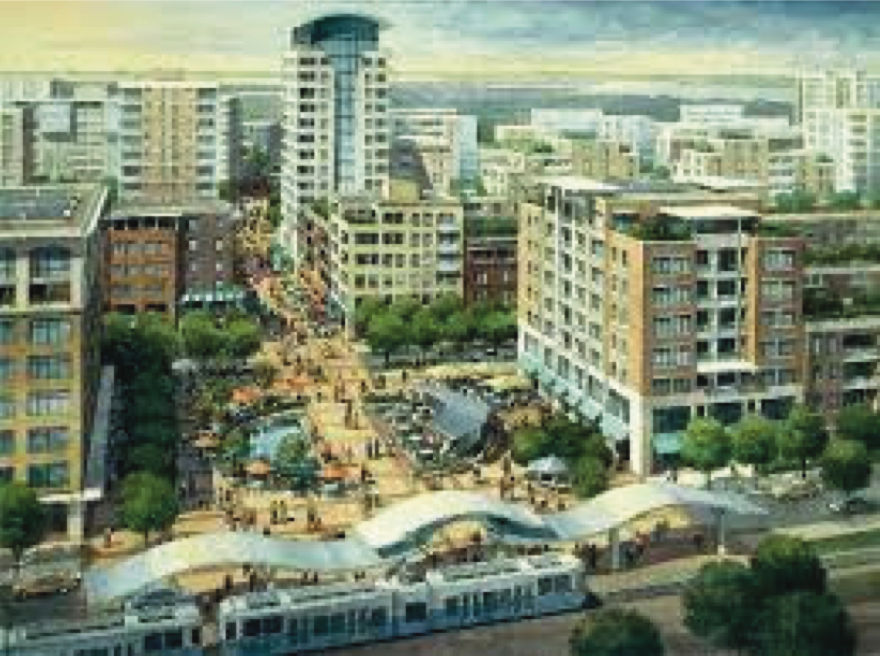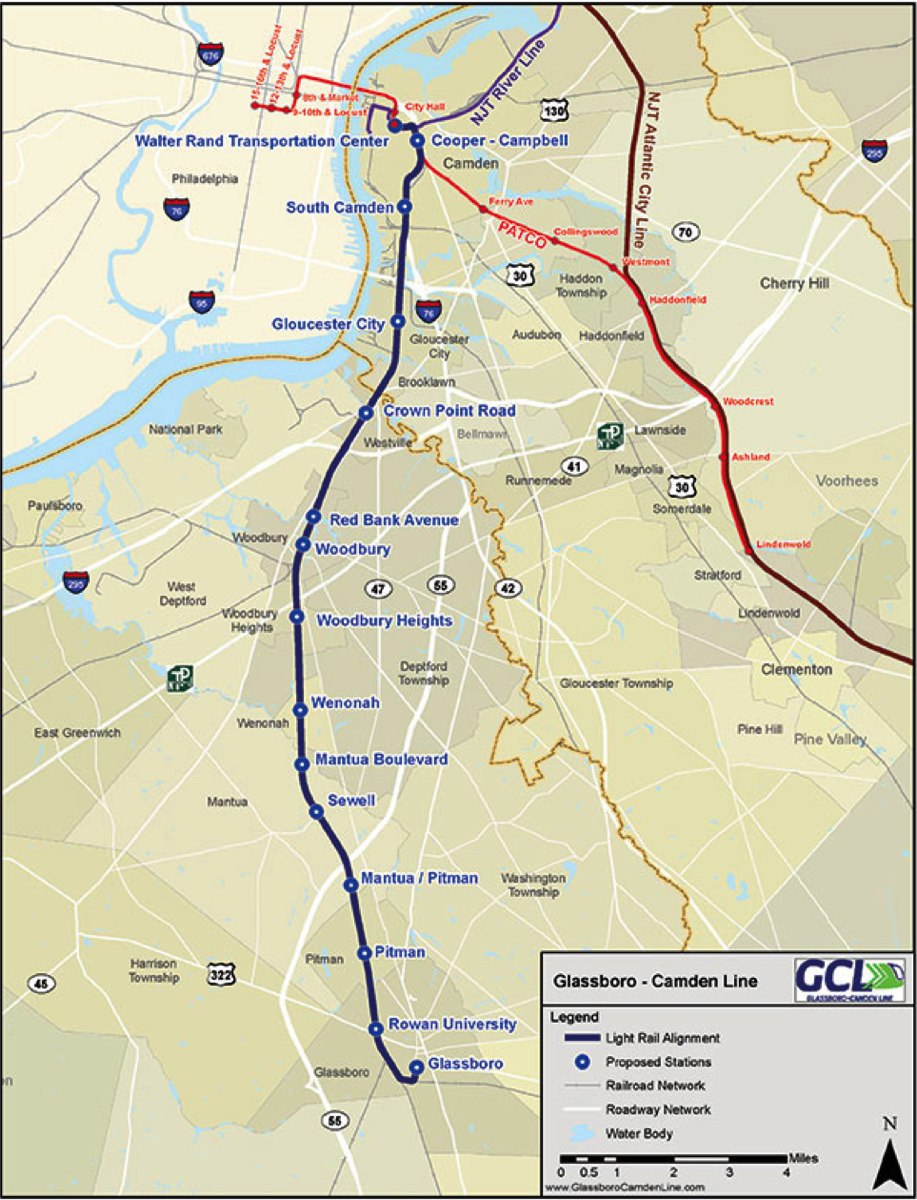Several strategic public transit improvements have queued up in recent years due to the scarcity of money. Completing these projects would greatly benefit New Jersey and its residents.
NJ TRANSIT HUDSON BERGEN LIGHT RAIL (HBLR)—NORTHERN BRANCH EXTENSION
The HBLR Northern Branch Extension would bring light rail to Bergen County, adding 10 miles to a much-used line that ends at a station in the Hudson County township of North Bergen. The extension, estimated to cost $1.2 billion and take four years to build, would run to Englewood Hospital.
Adding high-quality light rail service between these points would improve commuting options in densely populated, bus- and car-dependent eastern Bergen County. Destinations would include Hudson River waterfront points in Jersey City and Hoboken, Midtown and Lower Manhattan connections via Port Imperial ferries, PATH connections, and Hudson and Bergen County employment centers. Estimated increase in HBLR ridership would be 24,000 trips per day.
The construction schedule depends on completing environmental impact studies and cleanup, plus the availability of funding. Approval process for the Supplemental Draft Environmental Impact Statement is underway, with construction to follow after approval and engineering work.
New Jersey has been successful in acquiring federal funding for HBLR, and the project has been expected to score well in the competition for federal “New Starts” funding. New Jersey appropriated $28.5 million as a down payment, assuming 50% of the project would eventually be federally funded. But the proposed federal budget winds down New Starts. Only projects with a Full Funding Grant Agreement would be eligible, and the planned light rail extension lacks one.
While House and Senate Appropriations transportation subcommittees reduced the amounts available for New Starts, they made clear that the Federal Transit Administration’s structured procedures for evaluating, rating, and approval should continue indefinitely. Future levels of federal funding will remain a crucial subject.
NJ Transit still must negotiate a joint operations agreement with Conrail for the project to go forward, because Conrail operates some freight service on the Northern Branch. Since federal safety regulations prohibit light rail and freight from operating simultaneously over the same track, the parties will need to agree on non-overlapping schedules.

NJ TRANSIT HUDSON BERGEN LIGHT RAIL—ROUTE 440 EXTENSION
Extending the HBLR West Side Avenue branch two-thirds of a mile to a 100-acre brownfields site on the Newark Bay waterfront in Jersey City is critical to the Bayfront redevelopment plan. Light rail is expected to be as effective in stimulating redevelopment on the Newark Bayfront as it was on the Hudson River Waterfront in Jersey City. There are plans for up to 8,000 residential units and 1.8 million square feet of office and retail space. The extension would start from the West Side Avenue Park-Ride Station in Jersey City and follow the old rail alignment to the Bayfront. It would span Route 440, increasing pedestrian safety. Improved transportation access to downtown Jersey City, PATH stations, and Hoboken Terminal would generate a projected 8,000 trips.
Construction is expected to cost $173 million and take about two years. The schedule depends on completion of environmental cleanup (expected in 2017) and an indication that redevelopment activity is ready to proceed.
Capital costs are modest compared with overall redevelopment benefits. It is unclear how the project will fare in federal competition for New Starts funds. Some local matching funds will be needed, and are expected to come from the state’s revived
Transportation Trust Fund. The project has strong support from elected officials in Hudson County, and $4 million has been appropriated from the TTF to advance it.
As with the Northern Branch extension, the Trump administration’s position on transportation funding complicates prospects. The project’s moderate cost provides a potential advantage over more expensive projects elsewhere. The uncertain outcome of congressional funding debate could spur local officials and developers to revive the concept of using private operators or a public-private partnership to finance construction.


GLASSBORO—CAMDEN LIGHT RAIL
The proposed 18-mile light rail line would be built on an active Conrail freight alignment between downtown Camden and Glassboro. The estimated cost is $1.5 billion, plus however much is needed to acquire Conrail trackage or, if Conrail will not sell, to obtain an easement.
The project is in the Draft Environmental Impact Statement phase. Construction, expected to take about five years, could start in 2018. But the federal funding outlook is unclear. The relatively high cost and modest forecast of 18,000 trips per day mean the project will not rank well in national competition for money. The alternative would be full funding from the state Transportation Trust Fund, but there are other competing claims on that money. Other external sources of funding would have to be investigated to provide momentum.

LEHIGH VALLEY THIRD TRACK
Adding 5.7 miles of separate track to a key two-track rail segment owned by Conrail would aid passengers on NJ Transit’s Raritan Valley Line. The Raritan Valley Line is one of NJ Transit’s most dynamic, with constantly increasing ridership, proliferation of transit-oriented development, and aspirations for expanded one-seat service directly into New York Penn Station.
Two heavily used stations are located on this segment, at Roselle Park and Union Township (Kean University). Growth has been constrained, however, by a trackage-rights agreement that allows NJ Transit to operate a complement of peak-period trains but limits off-peak operations over the two tracks to one train in each direction per hour.
The third track would run from the Aldene connection in Cranford to Control Point NK near Weequahic Park in Newark. A third track would enable NJ Transit to add express peak and off-peak passenger rail service. And Conrail’s co-owners, Norfolk Southern and CSX, could add freight trains. The estimated cost is $250 million.
Conrail has cooperated in engineering, but offered right of way only as an in-kind financial contribution to the project. NJ Transit has sought unsuccessfully to win competitive federal funding for the project. Eligibility criteria have favored this type of project, but the Trump administration is looking to eliminate this funding category.
HUNTER FLYOVER
A new elevated structure alongside Route 21 in Newark would rise over the Northeast Corridor tracks and connect incoming Raritan Valley Line trains to Newark Penn Station tracks without interference from other NJ Transit and Amtrak trains.
Currently, 27 weekday and 18 weekend Raritan Valley Line passenger trains enter the Northeast Corridor west of Newark Penn Station through interlocking “at-grade” rails. This routing presents many conflicts with other trains and results in delays. NJ Transit, with Amtrak, has engineered the “flyover” solution.
The flyover would give Amtrak and NJ Transit more flexibility in scheduling trains in and out of Newark Penn Station at an estimated cost of $200 million.
NJ Transit may soon initiate an environmental study on this project.
MID-LINE LOOP AND NORTH BRUNSWICK STATION
The Mid-Line Loop is an overhead rail connector that would enable trains that now originate at County Yard, New Brunswick, for trips to New York to reach inbound New York City tracks without crossing the Northeast Corridor. This connector would eliminate at-grade conflicts between local trains and movements by high-speed and express trains on the Northeast Corridor.
The Mid-Line Loop also would provide access to new tracks that would serve a new North Brunswick station that would include an overhead pedestrian passageway and 1,300 parking spaces. This station would anchor more than 1 million square feet of major mixed-use development. The estimated cost of the loop is $300 million.
The project was halted after funds ran out in 2015.